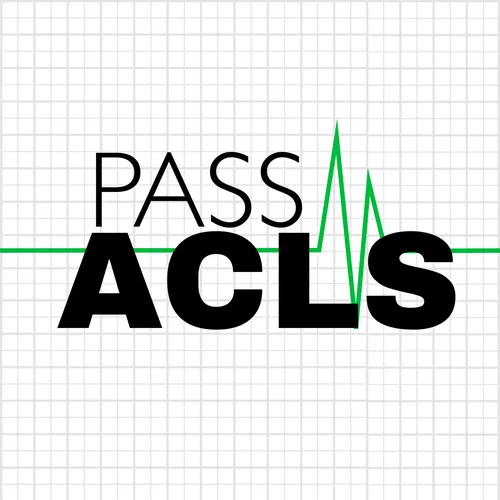
Pass ACLS Tip of the Day
I'm Paul from PassACLS.com and I'm here to help you pass ACLS. Like an audio flash card, this podcast is intended to aid any medical professional preparing for an Advanced Cardiovascular Life Support (ACLS) class. Each three-to-nine minute episode covers one of the skills needed to recognize a stroke or cardiac emergency and work as a high performing team to deliver safe, quality patient care.
Listening to a tip a day for a few weeks prior to your ACLS class will help cement the core concepts that have been shown to improve outcomes in patients suffering a heart attack, cardiac arrest, or stroke. In addition to the Chain of Survival, core concepts, and ACLS algorithms; specific information needed to pass the written exam, BLS checks, and megacode following the 2020 guidelines is presented.
Healthcare providers that are already ACLS certified, but rarely participate in codes, may find listening a helpful reminder.
Disclaimer: This podcast is a supplement to your course's approved text book and videos - not a replacement. The information presented is for educational purposes only, is intended for medical professionals, and is not medical advice. Medical professionals should follow their local laws, agency protocols, and act only within their scope of practice.
- Update frequency
- every day
- Average duration
- 5 minutes
- Episodes
- 81
- Years Active
- 2025

Antiarrhythmic Use After ROSC
Our primary focus immediately following return of spontaneous circulation (ROSC) is aimed at ensuring adequate perfusion of the patient’s vital organs and decreasing cerebral damage.
Post-arrest goals…

Hydrogen Ions as a H&T Reversible Cause of Cardiac Arrest
Hydrogen ions is on one of the Hs in ACLS's H&T reversible causes of cardiac arrest. When considering hydrogen ions as a cause, what we’re looking at is the patient’s pH, or acid/base balance, and c…

Adult Cardiac Arrest Code Flow
BLS & ACLS's Adult Cardiac Arrest algorithm makes it easier to act as team leader during a code by following an If/Then methodology.
Review of BLS steps for determining if rescue breathing or CPR is n…

Medication Review: Aspirin
Review of aspirin's mechanism of action, indications, contraindications, and administration for patients with acute coronary syndrome (ACS) or stroke.
Aspirin's mechanism of action & benefits for Acut…

First & Third Degree AV Blocks
Review of lead II ECG characteristics, rules to identify first and third degree heart blocks, and treatment following the ACLS Bradycardia algorithm.
To pass ACLS, you will need to be able to identify…

Antiarrhythmics: Lidocaine & Amiodarone
Review of antiarrhythmic medications Amiodarone & Lidocaine for use in ACLS's Adult Cardiac Arrest, Post Arrest, and Tachycardia algorithms.
The two first-line ACLS antiarrhythmics that are generally …

Nasopharyngeal Airway (NPA) Review
Review the indications, contraindications, sizing, and insertion of the nasopharyngeal airway (NPA) to maintain the airway of patients with a gag reflex.
The tongue is the most common airway obstructi…

Tamponade: An H&T Reversible Cause of Cardiac Arrest
The causes, physiology, signs & symptoms, and treatment of cardiac tamponade as an ACLS H&T reversible cause of cardiac arrest.
When blood, or other fluids, accumulate in the sac around the heart it’s…

The Team Leader Role and Use of Quick Reference Cards
The role of team leader, code team responsibilities, and the use of reference cards during your ACLS class megacode and written exam.
Two things have changed in recent years to aid students that don't…

Why Early CPR & Defibrillation is Important
Early CPR and defibrillation improve cardiac arrest outcomes. Here's why CPR is important and five ACLS tips to reduce CPR interruptions.
Two factors to cardiac arrest survivability that have been cle…

Quantitative Waveform Capnography Use in ACLS
Four uses for Quantitative waveform capnography in ACLS.
Waveform capnography use with, and without, an advanced airway in place.
Monitoring end tidal CO2 during rescue breathing.
Use of capnography to …

Vagal Maneuvers
Patients with a narrow complex tachycardia with a rate over 150 BPM are in SVT.
Unstable patients in SVT, or V-Tach with a pulse, should be cardioverted with a synchronized shock.
Assessment & treatme…

Defibrillation & Synchronized Cardioversion Energy Settings
Remembering all the different energy setting needed for synchronized cardioversion and defibrillation used to be confusing for a lot of people.
Defibrillators can be broken down into three basic categ…

Identification and Treatment of Unstable Bradycardia
Patients with a heart rate less than 60 are bradycardic. Some people can have a resting heart rate in the 40s without any compromise. For others, a heart rate of 50 or less could signify the need fo…

Post-Arrest Care & Targeted Temperature Management (TTM)
The goal of CPR is to keep the brain and vital organs perfused until return of spontaneous circulation (ROSC) is achieved.
Post-arrest care and recovery are the final two links in the chain of surviva…

The Chain of Survival for Cardiac & Stroke Emergencies
The chain of survival for ACLS is the same as was learned in your BLS class.
The beginning steps of the Cardiac Emergency and Stroke chain of survival.
ACLS's timed goals for first medical contact to P…

Hypokalemia & Hyperkalemia as a H&T Reversible Cause
Heart muscle contraction and repolarization is dependent on Sodium, Calcium, Magnesium, and Potassium ions crossing cellular membranes.
When a patient’s potassium levels get too low or too high, hypok…

Time Goals for Stroke Assessment & Therapy
When treating patients having an MI or stroke, more minutes equals more dead cells.
Because the majority of strokes are the ischemic type, the treatment for stroke is similar to an MI – to reestablish…

Medication Review: Adenosine
Adenosine is the first IV medication given to stable patients with sustained supraventricular tachycardia (SVT) refractory to vagal maneuvers.
Symptoms indicating a stable vs unstable patient.
Common c…

Second Degree Heart Blocks and Possible Interventions
To pass the written ACLS exam and mega code, students need to be able to identify basic ECG dysrhythmias, including the two types of second-degree heart block.
One method of ECG rhythm identification …